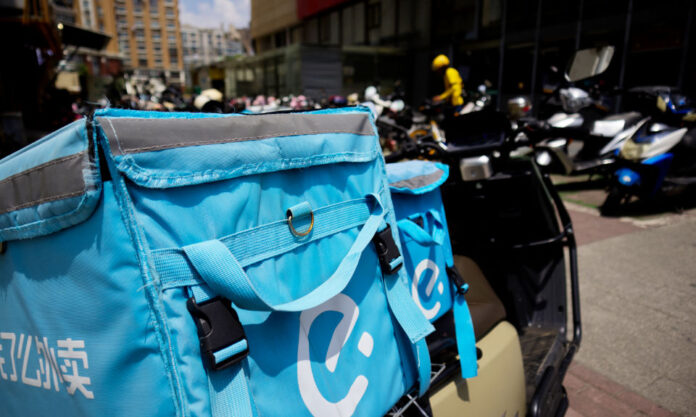Saying that food delivery in China has boomed is a colossal understatement. Over the last decade the size of its market has grown nearly 40 fold. While COVID was responsible for a lot of that, we haven’t transitioned away from food delivery because… Why would we?
The concept has become deeply embedded in modern Chinese culture simply because it is incredibly commodious for consumers; you can select your meal of preference, whilst sitting in the comfort of your own home wearing your favourite set of pyjamas and slippers.
However, like many other things, food-delivery services in China are not like in the West. One of the key differences is the procedure with regards to payment. In the West, it is likely that once the delivery driver arrives at your address, they expect to be paid in cash. In China, this interaction isn’t necessary as you normally are asked to pay on the app right before sending your order through. Therefore, when your order arrives, you can simply pick it up from your front door and dig in!
To do this, the preferable option would be to pay using Alipay or WeChat. It is possible to register a credit card for most Chinese food deliveries, however it can be slightly more difficult, especially for people who are not acquainted with the language. Paying with Alipay or WeChat pay is also a more systematic alternative as nowadays, the entire Chinese tertiary sector mainly offers one or both options as methods of mobile payment.
Why might Alipay be better than WeChat?
The main distinction between the two apps is that WeChat Pay is a supplementary attribute of a social communication software, while Alipay is solely a payment app. Therefore, WeChat Pay is more commonly used for everyday expenses that usually take place in person, while Alipay is known for being an effective method in carrying out online purchases.
The benefit of this is that your personal bank account is converted into an e-wallet. This will make it easier for you to enjoy fund transfers, withdrawals and credit-card-payment services without needing to worry about security issues such as whether owning an e-wallet will make it easier for others to steal your money. This is due to a forward-thinking variety of security measures, including encryption and two-factor authentication. So, you can sleep well at night knowing your money is secure and untouched.
Moreover, Alipay has started working in both domestic and international financial institutions such as Visa and Mastercard, thus helping it expand its reach and influence as to monetary affairs.
Issues within the food delivery industry
Although there is a plethora of food-delivery apps, it is not guaranteed that they can supply you with an English version.
For example, “美团外卖” (Meituan waimai) is one of the largest food-delivery apps in China that provide a range of cuisines from different food chains. And although you can search up the food you are looking for in English, it is also unlikely that the results or customisations are in any language other than Chinese.
The other dominant force in the food-delivery industry is “饿了么” (Eleme; a play on words with the Chinese for, “Are you hungry”), facilitating users in a range of activities that even go beyond the scope of ordering meals for a seemingly cheaper price than other well-known servers for the same quality of food. But, once again it lacks the option of choosing a language.
This could be daunting for non-Chinese speakers. But it’s actually a lot easier than it seems…
What to do?
Once you have downloaded your desired app, you can follow this set of steps (these can be applied to any Chinese food delivery program):
- Set up your profile. You will need to enter your Chinese phone number which you’ll be asked to confirm with a verification code.
- Insert your address. This might be the most precarious part of the process for non-Chinese speakers; hence, it may be a good idea to get a Chinese colleague or friend to help you make sure all your personal information is accurate. You really wouldn’t want your delicious dish to be delivered to the wrong address, would you?
- Select your food preference. You can do this by clicking on the numerous images and going through the list, or if you have a specific idea in mind for your meal, you can simply try searching it directly in English and see what pops up.
- Check out. Press the button at the bottom of the page to check out (去结算).
- Payment. Check your order is correct and press, “submit order” (提交订单) This will take you to your chosen payment option. The default will either be Alipay or WeChat Pay.
- Relax and wait for your order to arrive. Most restaurants will provide you with an estimated delivery time.
- Pick up your order. The delivery rider will call you when they arrive. If your Chinese is not so great, you only need one expression at this point; “Put it by the door” (放门口; fang men kou). You know what to do next!
It’s worth noting that many foreigners prefer to use Alipay for their food-delivery orders. Therein, the process is a little different, but on many levels, simpler. For example, there is no need to set up an account as you already have an Alipay account! The above step for inserting your address is at the end of the procedure, at which point you can also choose from a range of nearby options. Alipay also works exclusively with Eleme, which is generally a bit cheaper than Meituan for exactly the same thing.
As technology continues to advance, it is becoming clear that a cashless and digital-global society is the future for us. China is one of the few countries ahead of this curve, so while you’re here in the Middle Kingdom, why not take advantage of its financial arrangement and engage in Chinese e- commerce, especially when it comes to benign online transactions like ordering food delivery?







